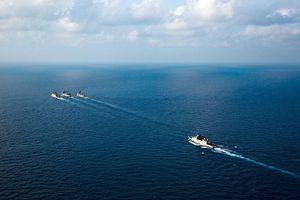Narendra Modi and Scott Morrison have been re-elected as the prime ministers of India and Australia, respectively. Their re-election is expected to provide continuity to the foreign policies of both countries, of which containment of China forms an important component.
This was evident immediately as Modi and Morrison formed their new governments. Prime Minister Modi invited the leaders of BIMSTEC (Bay of Bengal Initiative for Multi-Sectoral Technical and Economic Cooperation) as well as the President of Kyrgyzstan and the Prime Minister of Mauritius for his swearing-in ceremony. Modi chose the Maldives and Sri Lanka for his first visits abroad in his second term on June 8 and 9. Prime Minister Scott Morrison started his second term by visiting Solomon Islands on June 3.
Another important development was the meeting of officials from India, Australia, the United States and Japan in Bangkok on May 31 to discuss connectivity and reaffirming their commitment toward a free and open Indo-Pacific. The second terms of both the Indian and Australian prime ministers began by making efforts toward countering China (in India’s case China and Pakistan both) at bilateral as well as multilateral levels.
India-Australia relations could still be considered in a developmental stage. Relations between the countries were revived in Modi’s first term. In 2014, Modi became the first Indian prime minister to visit Australia in 28 years. Bilateral engagements have been considerably consistent since. Australian Prime Ministers Tony Abbott and Malcolm Turnbull visited India in 2015 and 2017 respectively. Indian President Ram Nath Kovind visited Australia in November 2018.
The Quadrilateral Security Dialogue, or the Quad, has been proposed as a mechanism between India, Australia, the United States, and Japan to promote the rules-based order and freedom of navigation in the Indo-Pacific. The Quad would provide an opportunity to India and Australia to deepen their strategic engagement. However, there are two principal challenges for both countries: different approaches with respect to China and limited engagements outside of the Quad framework.
Even though China presents a strategic challenge for India in the Indo-Pacific region, India is against targeting China by forging alliances with other countries. India supports multilateralism in order to protect interests of all the stakeholders. Modi, on different occasions, has reiterated India’s stand in this regard. On March 12, 2015 speaking in Mauritius he said that India has to recognize the interests that other nations have in the Indian Ocean. Similarly while delivering the keynote address at the Shangri-La Dialogue in Singapore on June 1, 2018, he spoke about inclusive engagement and that Indo-Pacific should not remain a limited club. In the case of Australia, its growing proximity to China during the prime ministership of Kevin Rudd has now been reversed and Canberra is drawing closer to Washington to counter Beijing’s influence.
As both India and Australia have been recalibrating their respective relations with China, this has affected their bilateral and multilateral engagements as well. India’s attempts toward balancing its relations with China against its own interests have restricted its interactions with Australia to some extent. This is particularly evident in strategic cooperation. India is a part of the Malabar Exercise that also includes the United States and Japan. Initially, the Malabar Exercise started as a bilateral exercise between India and the United States in 1992. Japan had been a non-permanent member due to China’s concerns but became a permanent member in 2015. A similar decision has yet to be taken in the case of Australia, which is not a part of the exercise. In order to pacify China, India did not invite Australia in the 2018 Malabar Exercise. However, India recently concluded a bilateral naval exercise with Australia (AUSINDEX), independent of the Malabar Exercise.
Whether or not the Quad will be materialized is yet to be seen. Even without the Quad, India’s interests may not be affected since India has strong economic and strategic relations with the United States and Japan. The United States is now India’s largest trade partner. Similarly India’s strategic cooperation with United States has been developing well for the past few years. India and Japan have strategic cooperation in different areas such as maritime domain awareness and the 2+2 dialogue. In 2017, India and Japan entered into an agreement for peaceful use of nuclear energy. Recently India and Japan together signed a deal with Sri Lanka to develop the East Container Terminal at Colombo Port.
At present, India is Australia’s fifth largest trading partner. But Australia is expecting India to play a bigger role in the Indo-Pacific region within the confines of the Regional Comprehensive Economic Partnership (RCEP). India and Australia signed a nuclear deal for the supply of uranium in 2014. Three years later in 2017 Australia started supplying uranium to India. Apart from these engagements, there is scope for realizing the full potential of India-Australia relations.
The fact that India has simultaneous engagements with the United States and Japan in different sectors, should act as a base to strengthen India-Australia relations. There is a need to work around the impediment that is caused by trying balance China’s objections with India interests.
The domestic political situation in both the countries in the recent past has also contributed to limited progress in bilateral relations. While India has enjoyed stable governments over the past two decades, Australia has experienced instability in the top echelons of government for the last decade. Five prime ministers in 10 years for Australia (three since 2014) have acted as a restriction in formulating and implementing a stable foreign policy or modifications to existing policy to suit changing global situations. But since now both the countries have continuity in governments some stability and progress should also be expected in bilateral relations.
Niranjan Marjani is an independent journalist and researcher based in Vadodara, India. He tweets at @NiranjanMarjani.

































